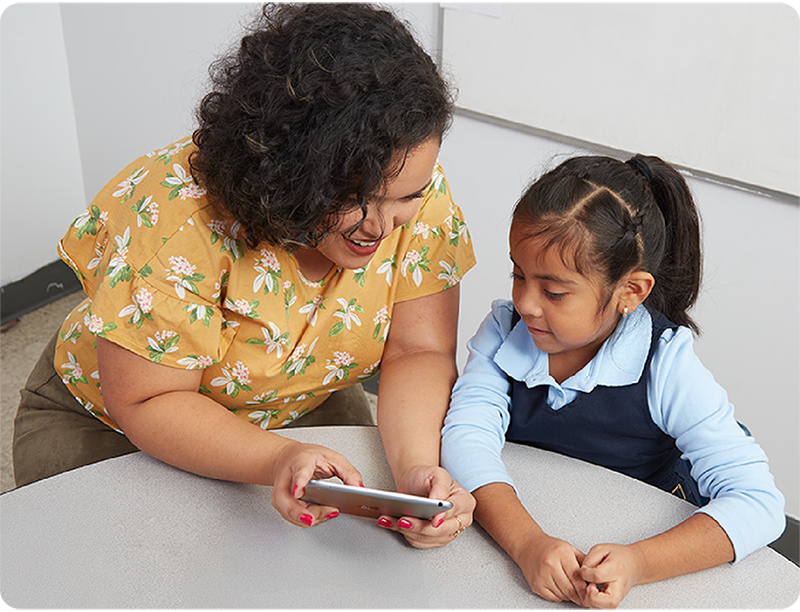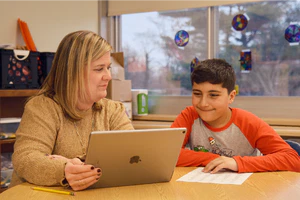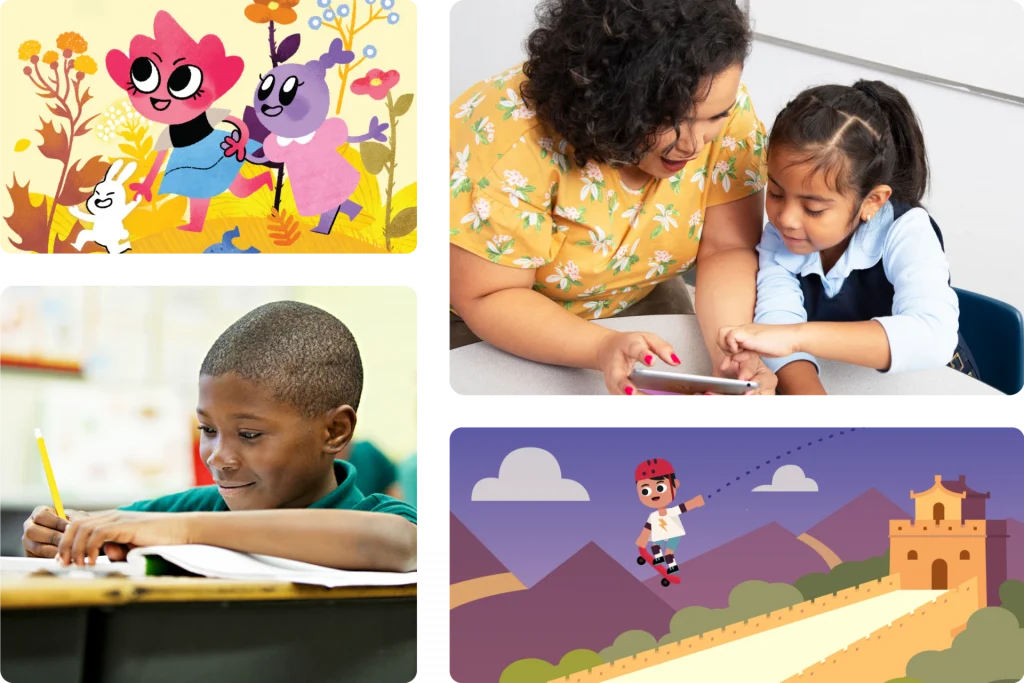Big gains but slow progress in reading readiness

Amplify’s end-of-year research brief for 2024–25 shows that the youngest learners have made the greatest progress with foundational reading skills in the last five years: more kindergarteners, first graders, and second graders are on track to learn to read and fewer are far behind than at any time since the pandemic.
Kindergarteners made the biggest strides in the knowledge and skills measured by elementary reading assessments, with 70% on track to learn to read—a 21-point improvement since the pandemic.
Post-pandemic slide
In 2020–21 (the year students returned to school after the pandemic shutdowns), only 55% of K–2 students were on track to learn to read by the end of the year.
The youngest cohort struggled the most, with only 49% of kindergarteners at or above benchmark.
More students on track to learn to read
But by the end of the 2024–25 school year, the overall picture of reading readiness was much brighter.
Our data shows a 13-point increase, with 68% of the youngest readers at or above benchmark.
First and second graders were also far ahead of where they were five years ago, with improvements of 14 and 8 points, respectively.
Progress slowing
While our 2024–25 end-of-year early reading data shows significant progress relative to 2020-21, the picture is less rosy when we compare it to last year:
- Overall, the number of K–2 students at or above literacy benchmarks was only one percentage point higher at the end of 2024–25 than it was at the end of the previous school year.
- Within that cohort, both kindergarten and first graders saw a 2% increase, but second graders only saw a 1% increase.
Fewer students far behind
Similarly, our data showed a significant drop in the number of young readers well below benchmark between the post-pandemic school year and the 2024–25 school year.
- Kindergarteners, again, showed the most improvement, with the number of students far behind dropping from 38% in 2020–21 to 20% at the end of the 2024–25 school year.
- Among first graders, we saw a 12-point decline in students who were not on track to learn to read compared to 2020–21
- Second graders showed the least improvement, with a decline of six percentage points relative to 2020-21.
Improvements among this cohort followed a similar trend to those of the at-benchmark readers: a noticeable decline over five years, but a barely noticeable year-over-year improvement.
- Only 1% fewer students across K–2 were far behind at the end of this year compared to the year before.
More improvement during the school year
Our data also revealed some good news about annual progress in early literacy development:
- Across K–2, students showed a bigger improvement in reading readiness than they did in prior years.
- By the end of the 2024–25 school year, 70% of kindergarten students were on track to learn to read, compared to 36% at the beginning of the year (the greatest improvement since 2020–21).
- First graders had a 19% improvement by the end of the 2024–25 school year (70% on track by end of year) compared to 56% in 2021.
- Second graders showed an 11-point increase in reading readiness from beginning to end of year (65% to 54%).
Putting the Science of Reading to work for students
“Grades K–2 remain critical years for literacy development,” said Susan Lambert, Chief Academic Officer of elementary humanities at Amplify and host of Science of Reading: The Podcast. “To support young readers, educators need data-driven insights into student reading development and instructional practices that are based in the Science of Reading.”
Research has shown that data-driven strategies and tools provide the best support for young learners’ future academic success. Here are a few of the ways teachers, administrators, and parents can put them into practice:
- Administering elementary reading assessments three times a year, to monitor student risk level for reading challenges
- Supporting students at risk for not learning to read by analyzing data from reading assessments and making informed decisions
- Allocating extra classroom time and resources to help students who aren’t on track
- Monitoring progress and making adjustments as needed
- Ensuring that evidence-based reading instruction is offered at every grade level
- Instilling a love of reading in and out of school, in partnership with caregivers and community
Let’s keep the conversation going! Join the discussion in our Amplify learning communities.
Dive into the findings in our End-of-Year Report.
More to explore
Alert: Progress in early literacy is slowing.

The latest middle-of-school-year data from Amplify show that throughout the spring and fall of 2023, schools across the country made some progress increasing the number of K–2 students on track for learning to read. But that progress is slowing.
Between 2021–2022 and 2022–2023, the number of K–2 students on track for learning to read increased by four to five percent across all grades; however, between 2022–2023 and 2023–2024, the increase was only two percent in each grade. Yet this is not the time for slow progress, because literacy rates in the United States are already a concern. Only half of K–2 students are on track for learning to read, and three in ten students are far behind.
To address slowing gains, schools and districts need to act now to accelerate literacy outcomes.
Early reading: Why we need to act now
The decline is especially urgent for students in kindergarten through the second grade. That’s because of what comes next: third grade, known to be the make-or-break year for reading and future academic success. To put it bluntly, students who are not proficient in reading before entering fourth grade are much more likely than their peers to struggle in school, and they are much more likely to drop out.
“The data is clear—literacy rates at the earliest and most critical time for student development are slowing. Changing this course requires schools and districts to act now and review their approaches in all grades,” says Susan Lambert, chief academic officer of elementary humanities at Amplify. “Schools that deliver strong outcomes focus on building a solid foundation at the start and intervening quickly when students need extra support, rather than trying to play catch up later, when it can be more difficult.”
The good news: We know what to do.
When students receive science-based reading instruction, literacy outcomes improve.
Changing these outcomes requires that districts and schools review the processes and practices they have in place at all levels. Schools that deliver strong outcomes focus on getting students on track—and often ahead—in the earliest grades, because it’s easier to get students ahead from the beginning than to catch them up later.
Districts should:
- Administer universal screening assessments three times per year to monitor levels of risk for reading difficulties.
- Allocate staff to support students who are at risk, spending additional time in literacy instruction beyond grade-level instruction.
- Regularly monitor progress for students who are at risk, making adjustments as needed.
- Ensure that instructional staff gain knowledge about science-based reading instruction and implement high-quality core curriculum with fidelity.
- Instill a love of reading and books during all school-based programs, with the support of caregivers and the community.
“The good news is that when students receive science-based reading instruction, outcomes improve,” Lambert continues. “And, when that instruction takes place in the earliest possible grades, research shows that most students can be taught to read at or approaching grade level.”
More to explore
Suite success: How we support early literacy

Educators are expected to balance and deliver assessment, differentiated curriculum, opportunities for higher-level thinking, and remediation—not to mention engaging content that holds student interest and hones early literacy skills. We’ve got to become efficient in numerous systems and platforms in order to pull it all off and help students succeed in early reading. It sounds nearly impossible—and I can honestly say that earlier in my career, it felt that way, too.
What changed that? The Amplify literacy suite. These products have not only fostered incredible growth among our students, but also transformed my experience as a teacher and, now, a literary coach.
I started my journey with Amplify products as a seasoned mCLASS® DIBELS® customer, where I put a lot of stock in the reading foundations’ measures and the data this system offers. The program led to rich data discussions and conversations around appropriate interventions and necessary classroom supports, yet it sometimes felt out of alignment with the curriculum content we used at the time. Our students weren’t always able to put their skills into practice in real time.
Then, a couple of years ago, the Science of Reading became a priority and we adopted Amplify CKLA. This program brought us worldly topics to expand our learners’ experiences, levels of rigor, differentiation, cyclical units of study, and science-based methods. This was the systematic, explicit early literacy curriculum we needed to connect skills and content!
Extending that connection, we found that mCLASS DIBELS paired with Boost Reading provided another layer of support for our students. This combo creates a personalized pathway to strengthen and challenge each learner at their level through engaging, interactive play. Together, these programs provide the perfect blend of actionable data and customized learning.
And just when I thought one platform could never meet the needs of all my students, we added mCLASS Intervention—the culminating piece to the suite, which serves our Tier 3 students (a group that includes even those who have received the Dyslexia Indicator through the mCLASS DIBELS assessment).
Balancing the needs of our readers can be overwhelming. We’re operating in a time of heightened need for proper reading instruction. Our world has never been more connected, and communication has never been a more important skill. The Amplify literacy suite is truly the most effective, balanced approach I have found. It meets your needs from start to finish—whether you’re the student, educator, interventionist, administrator, or parent.
More to explore
- Want to learn more about Amplify’s early literacy suite? Request your free sample or demo to start exploring.
- Listen to inspiring advice for educators, from educators at Teacher Connections—a collection of videos with practical advice and tools from your very own Amplify Ambassadors.
- Join thousands of educators like you by subscribing to Science of Reading: The Podcast.